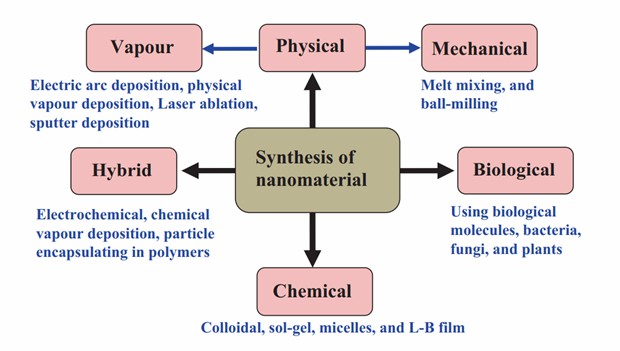Lifeasible supports research on the application of nanotechnology in plant protection and provides services to help design and synthesize a wide range of nanomaterials.
Nanomaterials have various uses in plant protection. Nanomaterials can be used for the detection and control of plant pathogens. Nanomaterials can be used to make sensors to detect the disease process of plants accurately. Nanomaterials can also improve soils, such as heavy metal soils. All of these nanomaterial applications contribute to the development of plant protection. We offer services to help research these nanomaterials and provide design and synthesis services for these nanomaterials. There are various methods for synthesizing nanomaterials (Fig. 1), which we flexibly utilize in the synthesis and optimization of nanomaterials.
 Fig. 1 A schematic illustration of different methods for the synthesis of nanomaterials (Omar et al., 2019).
Fig. 1 A schematic illustration of different methods for the synthesis of nanomaterials (Omar et al., 2019).
We mainly provide design and synthesis services for nanomaterials in plant protection.
Designing plant-synthesized nanomaterials
Synthetic nanomaterials using plants themselves have important uses in plant protection, including resistance to pathogenic microorganisms and as sensors for detecting plant disease processes. Lifeasible provides design services for in vivo synthesis of nanomaterials in plants to help design and develop genetically encoded sensors, in vivo anti-pest nanomaterials, in vivo anti-viral nanomaterials, and in vivo anti-microbial nanomaterials. If the nanomaterials are for use as sensors, we prioritize designing nanomaterials to be synthesized in chloroplasts. If the nanomaterials are for plant disease control, we design nanomaterial synthesis using gene editing in plant endophytes and plants themselves.
Design and synthesis of other nanomaterials
We also offer services for the synthesis of other nanomaterials in plant protection, including auxiliary nanomaterials to increase the effectiveness of pesticides, nanomaterials for plant disease control, nanomaterials for weed control, nanomaterials for activating plant resistance systems, external sensor nanomaterials (e.g., wearable nano-sensors), nanomaterials for plant disease detection kits, and soil improvement nanomaterials. In the design of the synthesis of these nanomaterials, we flexibly use a variety of physical, chemical, biological, and hybrid nanomaterial synthesis methods.
Various methods and advanced instruments for the synthesis of nanomaterials
We have a wide range of methods for synthesizing nanomaterials and have specialized instruments for synthesizing and analyzing nanomaterials. Our common approaches to nanomaterial synthesis include powder ball milling, gas-phase deposition, sol-gel syntheses, soft template approach, hydrothermal reactions, solvothermal methods, plant synthesis, fungal synthesis, and bacterial synthesis. For all the above physical and chemical synthesis methods, we have specialized synthesis instruments to perform synthesis. In addition, we have advanced instruments for the structural inspection of nanomaterials, including transmission electron microscopy (TEM), coupled plasma spectroscopy (ICP), X-ray spectroscopy, and UV-visible spectroscopy.
Increased application of environmentally friendly methods
In the design of nanomaterial synthesis, we prioritize environmentally friendly methods for nanomaterial synthesis, which helps to develop safer nanomaterial applications in plant protection to support a wider range of plant protection applications.
We prioritize the design of nanomaterial synthesis based on biosynthetic (including plant synthesis, fungal synthesis, and bacterial synthesis) methods. In addition, in synthesizing nanomaterials using abiotic synthesis methods, we design to utilize more biomaterials. For example, we design to use biomaterials such as amino acids, peptides, and polysaccharides for the reduction and coating of nanomaterials. We suggest using the peptides with plant disease control function to cover the nanomaterials, which can improve the application of nanomaterials in plant disease control.
Leveraging the current synthesis of nanomaterials
With a focus on environmentally friendly synthesis methods, we studied the synthesis of various nanomaterials currently used in plant protection. We validated and optimized these synthesis methods and accumulated experience to form our own set of synthesis protocols for plant-protection nanomaterials, which can help us rapidly design and synthesize nanomaterials for plant protection.
Lifeasible combines a variety of physical, chemical, and biological methods to design and synthesize nanomaterials for plant protection. We preferably consider designing plant-synthesized nanomaterials and designing environmentally friendly synthesis methods of nanomaterials, which can help expand the scope of plant protection utilization of nanomaterials. Please contact us to discuss the design and synthesis of relevant nanomaterials.
References
Lifeasible has established a one-stop service platform for plants. In addition to obtaining customized solutions for plant genetic engineering, customers can also conduct follow-up analysis and research on plants through our analysis platform. The analytical services we provide include but are not limited to the following:
Get Latest Lifeasible News and Updates Directly to Your Inbox
Adaptive Evolutionary Mechanism of Plants
February 28, 2025
Unraveling Cotton Development: Insights from Multi-Omics Studies
February 27, 2025